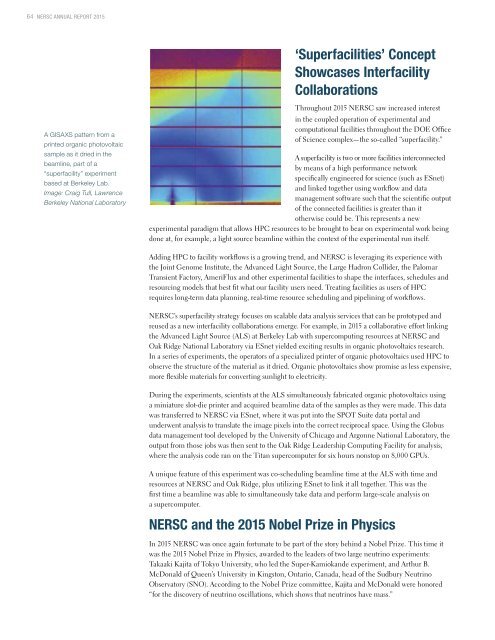National Energy Research Scientific Computing Center
BcOJ301XnTK
BcOJ301XnTK
Create successful ePaper yourself
Turn your PDF publications into a flip-book with our unique Google optimized e-Paper software.
64 NERSC ANNUAL REPORT 2015<br />
‘Superfacilities’ Concept<br />
Showcases Interfacility<br />
Collaborations<br />
A GISAXS pattern from a<br />
printed organic photovoltaic<br />
sample as it dried in the<br />
beamline, part of a<br />
“superfacility” experiment<br />
based at Berkeley Lab.<br />
Image: Craig Tull, Lawrence<br />
Berkeley <strong>National</strong> Laboratory<br />
Throughout 2015 NERSC saw increased interest<br />
in the coupled operation of experimental and<br />
computational facilities throughout the DOE Office<br />
of Science complex—the so-called “superfacility.”<br />
A superfacility is two or more facilities interconnected<br />
by means of a high performance network<br />
specifically engineered for science (such as ESnet)<br />
and linked together using workflow and data<br />
management software such that the scientific output<br />
of the connected facilities is greater than it<br />
otherwise could be. This represents a new<br />
experimental paradigm that allows HPC resources to be brought to bear on experimental work being<br />
done at, for example, a light source beamline within the context of the experimental run itself.<br />
Adding HPC to facility workflows is a growing trend, and NERSC is leveraging its experience with<br />
the Joint Genome Institute, the Advanced Light Source, the Large Hadron Collider, the Palomar<br />
Transient Factory, AmeriFlux and other experimental facilities to shape the interfaces, schedules and<br />
resourcing models that best fit what our facility users need. Treating facilities as users of HPC<br />
requires long-term data planning, real-time resource scheduling and pipelining of workflows.<br />
NERSC’s superfacility strategy focuses on scalable data analysis services that can be prototyped and<br />
reused as a new interfacility collaborations emerge. For example, in 2015 a collaborative effort linking<br />
the Advanced Light Source (ALS) at Berkeley Lab with supercomputing resources at NERSC and<br />
Oak Ridge <strong>National</strong> Laboratory via ESnet yielded exciting results in organic photovoltaics research.<br />
In a series of experiments, the operators of a specialized printer of organic photovoltaics used HPC to<br />
observe the structure of the material as it dried. Organic photovoltaics show promise as less expensive,<br />
more flexible materials for converting sunlight to electricity.<br />
During the experiments, scientists at the ALS simultaneously fabricated organic photovoltaics using<br />
a miniature slot-die printer and acquired beamline data of the samples as they were made. This data<br />
was transferred to NERSC via ESnet, where it was put into the SPOT Suite data portal and<br />
underwent analysis to translate the image pixels into the correct reciprocal space. Using the Globus<br />
data management tool developed by the University of Chicago and Argonne <strong>National</strong> Laboratory, the<br />
output from those jobs was then sent to the Oak Ridge Leadership <strong>Computing</strong> Facility for analysis,<br />
where the analysis code ran on the Titan supercomputer for six hours nonstop on 8,000 GPUs.<br />
A unique feature of this experiment was co-scheduling beamline time at the ALS with time and<br />
resources at NERSC and Oak Ridge, plus utilizing ESnet to link it all together. This was the<br />
first time a beamline was able to simultaneously take data and perform large-scale analysis on<br />
a supercomputer.<br />
NERSC and the 2015 Nobel Prize in Physics<br />
In 2015 NERSC was once again fortunate to be part of the story behind a Nobel Prize. This time it<br />
was the 2015 Nobel Prize in Physics, awarded to the leaders of two large neutrino experiments:<br />
Takaaki Kajita of Tokyo University, who led the Super-Kamiokande experiment, and Arthur B.<br />
McDonald of Queen’s University in Kingston, Ontario, Canada, head of the Sudbury Neutrino<br />
Observatory (SNO). According to the Nobel Prize committee, Kajita and McDonald were honored<br />
“for the discovery of neutrino oscillations, which shows that neutrinos have mass.”


